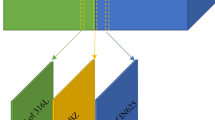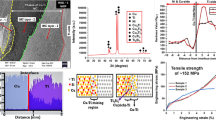Abstract
The CuCr/1Cr18Ni9Ti bi-metal materials were prepared by the solid-liquid bonding method. The microstructures, mechanical roperties and formation mechanism of the bonding interface were studied. The results show that there exists a serrated transition layer with a certain width at the interface of CuCr/1Cr18Ni9Ti bi-metal materials, and the transition layer consists of Fe-based and Cu-based solid solutions. The elastic modulus and hardness reach the maximum values at the interface closing to the 1Cr18Ni9Ti zone. The bonding temperature has a significant effect on the width and morphology of the transition layer. The interfacial bonding strength is at least 30% higher than that of the CuCr alloy, and the tensile fracture occurs at the side of the CuCr alloy rather than at the bonding interface.
Similar content being viewed by others
References
Qu W Q, Dong F, Qi Z G, et al. Advanced connection technology of dissimilar materials. Aeronaut Manuf Techn, 2006, 12: 32–34
Qinglei J, Yajiang L, Puchkov U A, et al. Microstructure characteristics in TIG welded bond of Mo-Cu composite and 18–8 stainless steel. Int J Refract Met H, 2010, 28: 429–433
Tayyebi M, Eghbali B. Study on the microstructure and mechanical properties of multilayer Cu/Ni composite processed by accumulative roll bonding. Mat Sci Eng A-Struct, 2013, 559: 759–764
Liu X, Lan S H, Ni J. Analysis of process parameters effects on friction stir welding of dissimilar aluminum alloy to advanced high strength steel. Mater Design, 2014, 59: 50–62
Cai X M, Luo Y. Adhesive properties study on the interfaces of AlN and metal of Pd, Ag and Cu. Sci China Tech Sci, 2011, 54: 11–14
Yang R J, Wu P, Li X L, et al. Effect of Cu on the boron segregation at grain boundaries and vacancy-type defects in ultra-low carbon micro- alloy steels. Sci China Tech Sci, 2014, 57: 1135–1141
Xu Q, Yoshiie T, Muroga T, et al. Microstructural evolution and hardness changes in the interface of Cu/316L bondt materials under aging and ion irradiation. J Nucl Mater, 2004, 329: 1558–1562
Durgutlu A, Gülenç B, Findik F. Examination of copper/stainless steel bonds formed by explosive welding. Mater Design, 2005, 26: 497–507
Sahin M. Bonding of stainless steel and copper materials with friction welding. Ind Lubr Tribol, 2009, 61: 319–324
Yao C W, Xu B S, Zhang X C, et al. Interface microstructure and mechanical properties of laser welding copper-steel dissimilar joint. Opt Laser Eng, 2009, 47: 807–814
Mai T A, Spowage A C. Characterisation of dissimilar bonds in laser welding of steel-kovar, copper-steel and copper-aluminum. Mat Sci Eng A-Struct, 2004, 374: 224–233
Sabetghadam H, Hanzaki A Z, Araee A, et al. Microstructural evaluation of 410 ss/Cu diffusion-bonded bondt. J Mater Sci Technol, 2010, 26: 163–169
Kaya Y, Kahraman N, Durgutlu A, et al. A novel approach to diffusion bonding of copper to stainless steel. P I Mech Eng B-J Eng, 2012, 226: 478–484
Yilmaz O, Celik H. Electrical and thermal properties of the interface at diffusion-bonded and soldered 304 stainless steel and copper bimetal. J Mater Process Tech, 2003, 141: 67–76
Le Marois G, Dellis C, Gentzbittel J M, et al. HIP’ing of copper alloys to stainless steel. J Nucl Mater, 1996, 233: 927–931
Wang H Q, Cao J, Zhang L X, et al. Research status of joining between copper alloy and steel. Weld Tech, 2009, 38: 1–5
Magnabosco I, Ferro P, Bonollo F, et al. An investigation of fusion zone microstructures in electron beam welding of copper-stainless steel. Mat Sci Eng A-Struct, 2006, 424: 163–173
Author information
Authors and Affiliations
Corresponding author
Rights and permissions
About this article
Cite this article
Zhang, Q., Liang, S., Zou, J. et al. Interfacial microstructure of CuCr/1Cr18Ni9Ti bi-metal materials and its effect on bonding strength. Sci. China Technol. Sci. 58, 825–831 (2015). https://doi.org/10.1007/s11431-015-5791-6
Received:
Accepted:
Published:
Issue Date:
DOI: https://doi.org/10.1007/s11431-015-5791-6




